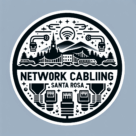What Two Types of Cables Are Used Most Commonly for Network Connections Today?
When it comes to building a reliable network, the type of cable you choose makes all the difference. Whether it’s for your home Wi-Fi setup or a large corporate office, using the right cables ensures faster speeds, stronger connections, and fewer interruptions.
So, what are the two most commonly used cables for network connections today? The short answer: Ethernet cables (twisted pair) and fiber optic cables. Both have distinct advantages, and understanding how they work can help you decide which one fits your networking needs best. Our team of structured cabling professionals in Santa Rosa ensures every installation meets the highest standards for speed, safety, and reliability.
1. Ethernet Cables (Twisted Pair)
Ethernet cables — also known as twisted pair cables — are the most widely used for wired network connections around the world. They connect computers, routers, switches, and other devices to deliver fast, stable data transmission.
Common Types of Ethernet Cables
- CAT5e (Category 5e): Supports speeds up to 1 Gbps and is suitable for most home or small business networks.
- CAT6 (Category 6): Offers speeds up to 10 Gbps over short distances with better insulation against interference.
- CAT6a (Augmented Category 6): Ideal for larger networks that need high performance and minimal crosstalk.
- CAT7 and CAT8: Used in data centers and enterprise-level environments where ultra-fast speeds and shielding are required.
Advantages of Ethernet Cables
- Cost-effective – Affordable installation and equipment.
- Easy to install – Compatible with standard connectors and ports.
- Reliable performance – Consistent speeds and minimal latency.
- Versatile – Works for both residential and commercial applications.
Ethernet cabling continues to evolve, offering higher speeds and better shielding with each generation — making it a dependable choice for most network infrastructures.
2. Fiber Optic Cables
Fiber optic cables are the second major type of cable used in modern networking — and they’re known for their incredible speed and long-distance performance.
Instead of transmitting data using electrical signals (like copper cables), fiber optic cables use light signals. This allows data to travel much faster, with almost zero signal loss or interference.
Types of Fiber Optic Cables
- Single-mode fiber (SMF): Transmits data through a single strand of glass fiber — ideal for long distances (up to several miles).
- Multimode fiber (MMF): Uses multiple light paths — perfect for shorter distances like within buildings or campuses.
Advantages of Fiber Optic Cables
- Ultra-fast speeds – Supports 10 Gbps, 40 Gbps, or even higher bandwidth.
- Long-distance performance – Minimal signal degradation over miles.
- Immunity to electromagnetic interference (EMI): Perfect for environments with heavy machinery or radio signals.
- Future-proof technology – Capable of supporting next-generation network demands.
While fiber optic cabling is more expensive than copper, it delivers unmatched performance for businesses and organizations that need maximum speed and reliability. To understand why these cables are so essential, read about the primary function of network cabling in modern infrastructure.
Ethernet vs. Fiber Optic: Which Should You Choose?
| Feature | Ethernet (Twisted Pair) | Fiber Optic |
|---|---|---|
| Speed | Up to 10 Gbps (CAT6/6a) | Up to 100+ Gbps |
| Distance | Up to 100 meters | Up to several kilometers |
| Interference | Moderate protection | Immune to EMI |
| Cost | Affordable | Higher initial cost |
| Best For | Homes, small offices | Large businesses, data centers, campuses |
If your network setup is local — such as within a single building or home — Ethernet cabling is likely sufficient. But if you’re connecting multiple buildings, supporting large data loads, or planning for future expansion, fiber optic cabling is the smarter long-term investment.
Why Professional Installation Matters
Whether you choose Ethernet or fiber, professional network cabling installation ensures optimal performance and safety. Certified installers test every connection, follow local building codes, and use high-quality materials to guarantee your system runs smoothly.
Proper installation also prevents issues like signal interference, improper termination, or cable damage — problems that can affect your speed and reliability over time.
Final Thoughts
The two most commonly used cables for network connections today — Ethernet (twisted pair) and fiber optic cables — both have their place in modern networking.
- Choose Ethernet if you want a cost-effective, easy-to-install solution for homes and small businesses.
- Choose fiber optic if you need higher speeds, longer distances, or a system that’s ready for the future.
Beyond these two common options, there are several others worth knowing — explore the five main types of network cable and their specific uses.
By working with a trusted network cabling expert, you can design and install the perfect combination of both technologies for your property — ensuring speed, security, and performance for years to come.
